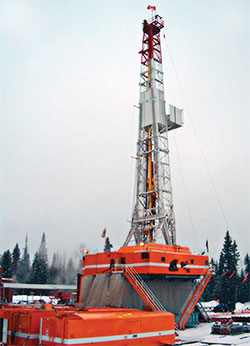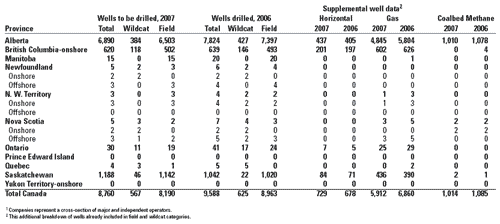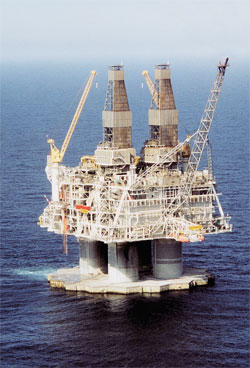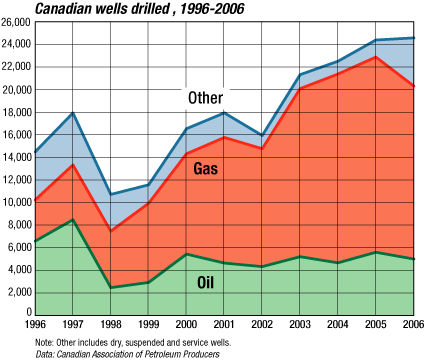Outlook 2007: Canadian Outlook
Canada skirts the precipice
Despite another remarkable year for activity in 2006, the Canadian oil patch casts a wary eye to a future clouded by a mercurial political landscape
Robert Curran, Contributing Writer, Calgary
Notwithstanding a substantial reduction in natural gas prices and some minor softening of oil prices, the Canadian industry set more records in 2006. This performance was highlighted by new high-water marks for drilling and land sales.
OVERVIEW
Even with the pricing downturn—oil is trading at C$63.50/bbl (about US$54, compared to C$70.80 in January 2006) and natural gas is at C$6.70/Mcf (versus $8.70)—there was enough optimism that the word “boom” once again slipped into the common parlance.
Even now, that confidence seems reasonable. With gas prices off slightly, industry shifted its focus to more oily prospects. Even at C$60/bbl (US$51/bbl), most oil projects are economical. And industry has been riding a wave that really began in 2003—the first of four consecutive record years. Most forecasters project continued strong demand and high prices for many years to come.
But as personal affluence tends to breed philanthropy, so does a booming industry soften public resistance to increasing royalties, taxing polluting industries or subsidizing green technology. The high profits and confidence born of a high-priced market (fed by seemingly insatiable global demand growth) have emboldened environmentalists, and attracted the interest of politicians eager to court public opinion. Coupled with the political uncertainty caused by a minority federal administration and a neophyte Alberta premier, a booming industry fears it may become an easy target for elected officials looking to court public opinion.
The Canadian industry has responded with aggressive marketing and lobbying efforts that remind the public, and their elected representatives, that this is a cyclical industry. The superheated economy has negative repercussions as well, like skyrocketing prices in the service industry, a shortage of skilled workers, and a skittish investment community determined to reduce its oil and gas exposure before the inevitable downturn occurs.
 |
Canadian drilling will increasingly shift toward oil in 2007, until gas prices firm. Photo courtesy of Trinidad Energy Services Income trust.
|
|
POLITICAL ASPECTS
A clear example of the capricious nature of both politicians and the market occurred on Oct. 31, 2006, when the ruling federal Conservative party—led by Calgary’s own Stephen Harper—unveiled a proposal to tax distributions made by Canadian income trusts. It was seen as an effort to rein in an increasing level of what federal Finance Minister Jim Flaherty called “corporate tax avoidance.”
Although the proposal contained a four-year transition period before trusts would have to start paying taxes, the reaction was one of disbelief and anger, as investors dumped trust units on Nov. 1, dropping the value of the Toronto Stock Exchange’s income trust index by 12%. Many industry players lashed out at the feds, claiming that the Conservatives had previously assured them that this type of change would not occur.
In mid-December, the Conservatives subsequently outlined more details of their plan, allowing trusts to grow by 40% through 2007, and another 20% in 2008, 2009 and 2010. The Conservatives also said the revisions would allow trusts to eventually convert back to regular corporations without any tax consequences.
Nonetheless, many industry observers predict the new rules will lead some companies to abandon mergers, acquisitions and conversion plans. They also think it may lead to a resurgence of a virtually extinct entity known as the mid-sized Canadian E&P company. In fact, the first such switch was announced in early 2007, when True Energy Trust said it would make the switch back to operating as a mid-sized E&P company. It had originally converted to trust status in November 2005. True has production of about 20,000 boed.
In early January, the unrelenting pressure from industry appeared to pay off, as the Conservatives offered to re-open the issue via hearings in front of the House of Commons Finance Committee, set to begin in early February.
The Conservatives also made a couple of moves that seem to indicate their intent to take a greener line on environmental issues. First, they unveiled their Clean Air Act, designed to cut Canada’s greenhouse gases in half by 2050. They’ve also shuffled their cabinet, replacing Alberta’s Rona Ambrose with Ontario’s John Baird.
In Alberta, the political outlook has been clouded. Ed Stelmach, Alberta’s new premier, announced that a review of the province’s oil sands royalty structure will be conducted in 2007. Currently, oil sands producers enjoy a virtual, production royalty holiday from their massive projects until they recover their initial capital investments.
There is more uncertainty on the federal front in the person of Stéphane Dion, the newly minted leader of the federal Liberal party, which is Canada’s opposition to the ruling Conservatives. Dion has mused publicly about increasing the federal oil sands royalty, or eliminating royalty incentives if industry players fail to meet unspecified emissions standards. Recent polls place the Liberals ahead of the Conservatives among the Canadian electorate.
Given the precarious nature of minority governments, and the fact that CIBC World Markets recently released a report that predicts regulations governing carbon dioxide emissions will be in place across Canada and the U.S. by 2010, industry’s nervousness seems well-founded.
ECONOMICS
Overall, the oil and gas sector showed positive growth in 2006, but gas-weighted producers and income trusts dragged the broader index down, preventing a repeat of the tremendous increase in value that oil and gas companies experienced in 2005.
Not surprisingly, spending is expected to fall in 2007. The Canadian Association of Petroleum Producers (CAPP) is predicting that E&P spending will decline 9.1%, to C$40.0 billion, compared to C$44 billion in 2006. However, oil sands spending appears to be headed in the opposite direction, as producers focus activity in Alberta’s capital-intensive oil sands areas.
Some of Canada’s top spenders in 2007 are expected to be EnCana Corp., with a budget of C$6.79 billion (down 6% from 2006); Canadian Natural Resources Ltd., at $6.25 billion (down 45%); Suncor Energy Inc., at $5.3 billion (up 50%); Talisman Energy Inc., at $4.8 billion (flat); Petro-Canada, at $4.06 billion (up 15%); Shell Canada Ltd., at $4 billion (up 50%); Husky Energy Inc., at $3.18 billion (up 12%), and Nexen Inc., at $2.9 billion (down 12%).
Slumping natural gas prices have shifted industry’s spending focus toward oil, and uncertainty over the intentions of federal and provincial governments conspired to dampen merger and acquisition (M&A) activity as the year grew long. Still M&A levels fell just shy of $30 billion in 2006.
As usual, rumors abound as to which companies are looking to sell or buy, with most of the speculation focused on companies whose portfolios are heavily weighted to natural gas. One such company is Trident Exploration Corp., one of Canada’s fastest rising oil patch stars just a year ago (and one of a new breed of Alberta companies dedicated to coalbed methane plays). But now, awash in debt, it has been seeking a buyer and/or looking to restructure its debt.
Some of the larger M&A transactions in the second half of 2006 include:
• In October, Royal Dutch/Shell plc announced its intent to acquire the remaining shares of Shell Canada Ltd. that it did not already own, a deal worth C$7.7 billion.
• In September, Canadian Natural Resources announced it had agreed to acquire Anadarko Canada Corp. for C$4.69 billion.
• In December, TransCanada Corp. announced plans to take over ANR Pipeline Co. and ANR Storage Co. from El Paso Corp. for C$3.9 billion.
• In November, Pengrowth Energy Trust announced it would be acquiring assets from ConocoPhillips for $1 billion. The assets were formerly held by Burlington Resources Canada Energy Ltd.
DRILLING
Despite the slump in natural gas prices, oil drilling increases offset gas drilling declines sufficiently to ensure that drilling activity hit yet another record in 2006. Given the overall climate of uncertainty, the record trend is expected to end in 2007, and levels may fall substantially, although there is some doubt as to which forecast will fall closest to the mark.
Depending on which source one consults, last year’s overall figure can vary noticeably. According to Daily Oil Bulletin (DOB) records, the number is 22,171 wells, up less than 1%. Within that DOB total, natural gas drilling was down slightly, at 15,317 wells, compared to 15,359 in 2005, but it still counted for more than 69% of wells drilled. There were 5,609 oil wells, (up 16%), 1,076 dry holes and 169 service wells. Just over 25% of the wells drilled in 2006 were exploratory.
Both the drilling and service association figures are different from DOB, and the discrepancies lie in how some wells are categorized and counted. Also, these groups have predicted lower totals, primarily due to a drop off in gas drilling.
For instance, the Canadian Association of Oilwell Drilling Contractors (CAODC) estimates 21,927 wells were drilled in 2006. For this year, CAODC has the most bearish outlook, predicting a total of 19,023 wells drilled for a 13.2% decline. CAODC based its forecast on an average WTI price of US$65/bbl, and an average NYMEX spot natural gas price of $6.50/Mcf. CAODC is also predicting that rig utilization will average 51% in 2007, compared to 62% in 2006. In response to continued high demand for rigs, the rig fleet is expected to increase yet again, to 833, up from 797.
| What 30 Canadian drillers plan for 20071 |
 |
|
The Petroleum Services Association of Canada (PSAC) has a higher estimate for 2006 at about 24,200 wells, when eastern Canada is included. Accordingly, PSAC has come out with a more bullish forecast for 2007, projecting 21,500 wells will be drilled this year (down 11.2%). PSAC believes that shallow gas and coalbed methane drilling will decline the most. Its forecast is based on a WTI average of US$60/bbl, and C$6.25/Mcf at Alberta’s AECO storage hub.
By contrast, CAPP estimates about 24,700 wells for 2006, when all types of service completions are included. Although the association’s official forecast for 2007 is 22,013 wells, CAPP acknowledges that this figure may be a bit optimistic.
World Oil survey results. Meanwhile, World Oil conducted its annual survey of Canadian producers. When extrapolated to full industry numbers, the survey results are in line with the CAODC and PSAC forecasts in terms of relative percentage drop. Respondents indicate that they plan to drill 8,760 wells in 2007, down 8.6% from the 9,588 wells they drilled in 2006. This translates to a projection of about 22,500 wells to be drilled this year.
This is the first time in several years that World Oil’s survey participants have been in synchronization with the CAODC and PSAC numbers. Traditionally, this survey group has come in with a lower forecast of activity than the associations.
The survey also indicates another decline in the gas share of total drilling. Last year, the respondents targeted 72% of their efforts toward gas. This year, that figure drops to 68%. Just a couple of years ago, these firms were directing well over 80% of their drilling toward gas. The numbers also show that exploratory drilling will remain steady, with about 6.5% of wells planned for that category this year.
The survey group’s activity is expected to fall 11.9% in Alberta, decrease 3.0% in British Columbia, and increase 14.0% in Saskatchewan. By comparison, regulatory officials project declines of 0.4%, 30.l% and 6.6% in these provinces, respectively.
PRODUCTION
According to figures supplied by CAPP, Canadian oil production, including oil sands, averaged 2.59 million bpd during 2006. Within that figure, conventional crude output was about 1.45 million bpd. Producing oil wells reached and exceeded the milestone of 60,000, totaling 60,222. Of this amount, 3,200 wells were flowing, including 50 offshore.
Alberta contributed about 1.96 million bopd, including oil sands, followed by Saskatchewan at nearly 420,000 bopd. East Coast output from Newfoundland and Nova Scotia averaged about 290,000 bopd. British Columbia, Manitoba and Northwest Territories contributed 42,151 bopd, 20,679 bopd and 19,000 bopd, respectively.
Throughout Canada, natural gas production averaged 17.3 Bcfd (including 300 MMcfd offshore), equivalent to 6.31 Tcf annually. Active producing gas wells totaled 131,630. About 82% of the country’s gas output, roughly 14.1 Bcfd (5.15 Tcf annually) was in Alberta. The lion’s share of the remainder was produced in British Columbia.
OIL SANDS
If the importance of Alberta’s massive oil sands deposits was ever in doubt, consider how this activity continues to exceed itself, year after year, even with the uncertain factors that trouble the industry.
The last half of 2006 included three hearings to consider applications for oil sands mining projects: one from Suncor (for its North Steepbank Mine expansion and adjacent upgrader); one from Albian Sands Energy Inc. (to expand its Muskeg river mine); and one from Imperial Oil (for the mine, pipeline and upgrader associated with its Kearl Oil Sands Project).
Both Suncor and Albian have received approval for their projects, although the booming activity in Fort McMurray has prompted calls for infrastructure upgrades in the area. It has also sparked a war of words between certain industry players and provincial politicians over their respective responsibilities to ensure that the local community has the means to handle the massive influx of residents and workers associated with the booming industry.
Meanwhile, Husky opened its C$500-million, 30,000-bpd Tucker project near Cold Lake, Alberta, on news that it was completed, on time and on budget. And Canadian Natural in late 2006 reached the half-way point in constructing its Horizon project. First oil is expected in late 2008.
Looking further ahead, Shell Canada has filed applications with regulatory authorities for its 100,000-bpd in situ project in Alberta’s Peace River region, and by Fort Hills Energy, for its Sturgeon Upgrader, just northeast of Edmonton, Alberta.
EAST COAST/LAND SALES
On the East Coast, the news has been mixed. In the second half of 2006, Husky had good news, logging oil discoveries near Terra Nova field, offshore Newfoundland, and adding 190 million bbls to White Rose field following a successful delineation program. On the down side, the Newfoundland government rejected a proposal to develop the Hibernia South offshore oil field, saying it didn’t receive enough information from the companies involved, reported the Canadian Press.
The partners that issued the proposal last May include ExxonMobil, Chevron, Petro-Canada and Norsk Hydro. The decision overturns a conditional approval granted in December by the Canada-Newfoundland and Labrador Offshore Petroleum Board. The board estimates that Hibernia South contains about 223 million bbls of recoverable oil.
On behalf of the partner companies, the Hibernia Management and Development Corp. (HMDC) applied last May to amend its development plan for the Hibernia oil field. In a prepared statement, Natural Resources Minister Kathy Dunderdale said, “There are too many important unanswered questions in the application. Without additional information, we cannot make an informed decision.” In late January, HMDC indicated that it would revise and re-submit its proposal.
 |
The Hibernia field partners will have to re-submit their application, if they want to proceed with developing the field�s southern extension offshore Newfoundland. Photo courtesy of Hibernia Management and Development Corp.
|
|
Finally, land sales established another record last year, sparked by a skyrocketing increase in Alberta oil sands leases. Governments took in C$4.24 billion, almost 45% higher than the $2.93 billion collected in 2005. Of that, just under half came from oil sands leases (C$1.96 billion). Alberta again took most of the revenue, generating C$3.43 billion (81% of the Canadian total). Once again, the province, on its own, exceeded the Canadian total from the previous year.
|
THE AUTHOR
|
|
Mr. Curran is a Calgary-based freelance writer.
|
|
|






